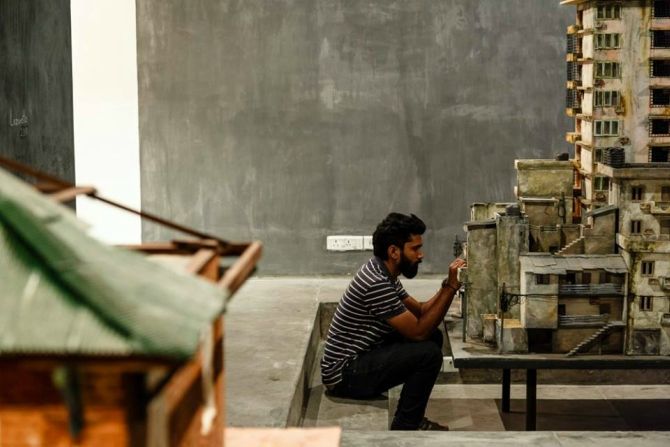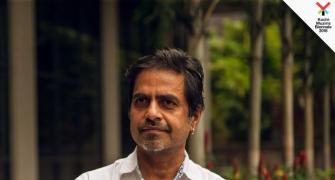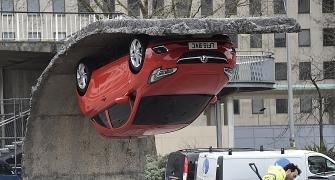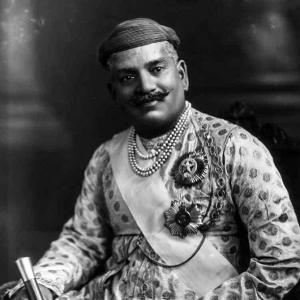Galleries and collectors are warming up to video art, discovers Avantika Bhuyan.

Photograph: @ExperimenterGallery/Facebook.
For nearly a month, starting September 2, 2017, video art took centrestage at Sunaparanta -- Goa Centre for the Arts.
Curator Siddharth Dhanvant Shanghvi had gleaned works from the private collection of Anurag and Payal Khanna for the show Longing. Works on display included those by Hassan Khan, Akram Zataari, Matthias Müller and Alejandro Cesarco.
The show served to shine a light on the fact that video art, or 'new media art', as the current term goes, is a new, important space for experimentation with ideas, narratives and exhibition formats.
With the transition from analog to digital, and with cameras becoming cheaper and ever-more easy to use, video is now an accessible medium. A natural corollary of this technological advancement is that more and more artists are working in this medium, and in a multiplicity of ways.
'Many are finding that collectors are happy to acquire works in this medium, with proper contracts, and the acceptance is generally increasing over time,' says Anurag Khanna, whose collection features video works by both Asian and Western artists.
Although the advent of video art in India dates to the 1990s -- when Vivan Sundaram created a memorable work in 1993 in response to the Mumbai riots, Nalini Malani produced Toba Tek Singh in 1998 and Sonia Khurana created Bird in 1999 -- avenues to show video art remained few and far between. Galleries and institutions often lacked the infrastructure to showcase these works.
However, today, a new ecosystem is emerging around video art.
Art spaces, collectors and artists are working together to create novel ways of engagement with this art form.
No overnight change this, but one that has taken years of consistent effort.
Experimenter Gallery, Kolkata, for one, has been showing video art by Bani Abidi, CAMP and Naeem Mohaiemen for nearly 10 years. And its new show -- a solo by Sahil Naik, titled Ground Zero: Site as Witness/Architecture as Evidence, which opened last month, further explores this genre.
Delhi's Gallery Espace, too, has contributed to the rise of video art. Its founder, Renu Modi, organised Video Wednesday in 2008-09 and then again in 2011-12 -- year-long programmes to showcase contemporary video art by artists such as Gigi Scaria, Navjot Altaf, Yang Fudong and Ranbir Kaleka.
Institutions such as the Kiran Nadar Museum of Art (KNMA) have been presenting works by artists like Nalini Malani on a scale that was previously unheard of.
'We also sponsored the film that Amar Kanwar did for Documenta,' says Kiran Nadar, chairperson, KNMA, and avid collector of video art.
While video art may be the next big thing for art practitioners and gallerists, what of the consumer of art?
Viewers' reactions also seem to point to a shift in their engagement with the genre.
'For Jewel by Hassan Khan and its transfixing music, local school kids were dancing along to the piece -- this was such a tender moment, free from the artifice of much of the art world,' says Shanghvi.
The Khannas and Nadar started collecting video art when it was at a nascent stage in India.
'Private collectors don't usually buy video installations, as there is no space to put them up. And yet, you see a Nalini Malani video installation at the KNMA,' remarked gallerist Peter Nagy, in an earlier interview, about Nadar's discerning collecting style.
It is the emotional resonance of these works that prompted Nadar to acquire video art, she says.
Her extensive collection now features video art by Amar Kanwar, Neha Choksi, Bani Abidi, Nalini Malani and Sonia Khurana.
Aspiring collectors should note, though, that video art is not for those who have just embarked on their collecting journeys.
'It is more for a seasoned collector. Some collector friends of mine, from around the world, have progressed from photography to video. Some collect video works, as they create a large spectacle and add value to the collection,' says Prateek Raja, Co-founder, Experimenter Gallery.
One needs to have had consistent exposure to the oeuvre of different artists to know which of their works to choose from.
For instance, Naeem Mohaiemen's works have a longer duration -- ranging from 45 minutes to 95 minutes -- and might have a narrative embedded in history and politics, or none at all. While he uses video as a vehicle of expression, work by artist collectives such as CAMP question the medium itself through works such as From Gulf to Gulf to Gulf.
A final cautionary note: ideally, you should know how to keep up with technology, as video is a very dynamic medium. After all, what one might buy today might not even be possible to play 20 years hence. Remember the VCD?











